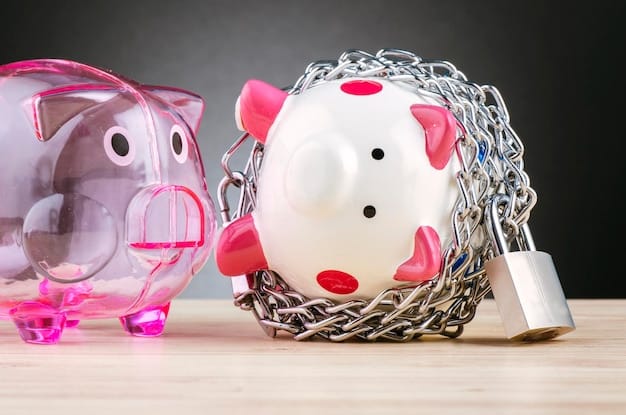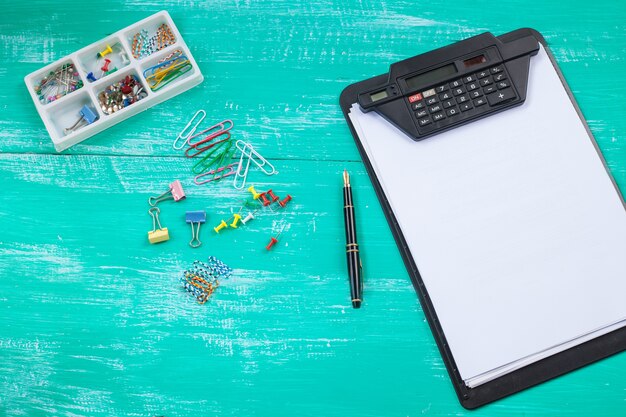Emergency Fund Essentials: Calculate Your 3-6 Month Coverage

An emergency fund is crucial for financial security, and calculating 3-6 months of living expenses provides a safety net to handle unexpected events like job loss or medical emergencies, ensuring financial stability during challenging times.
Building an emergency fund is a cornerstone of sound personal finance. It acts as a financial cushion, safeguarding you from life’s unexpected curveballs. But how do you determine the *right* amount? This article will guide you through calculating exactly how much you need to cover 3-6 months of expenses, empowering you to build a robust safety net.
Why You Need an Emergency Fund
Life is unpredictable. Job loss, medical emergencies, unexpected home repairs – these events can derail even the most carefully planned budget. An emergency fund provides a crucial buffer, preventing you from accumulating debt or making drastic financial decisions during times of crisis.
Without an emergency fund, you might find yourself relying on credit cards, taking out loans, or even dipping into retirement savings. These options can be costly and have long-term financial consequences. A well-funded emergency fund offers peace of mind and protects your financial well-being.

The Cost of Not Having an Emergency Fund
Ignoring the need for an emergency fund can lead to a cascade of financial problems. Here are a few potential consequences:
- Increased Debt: Relying on credit cards or loans during emergencies can quickly lead to high-interest debt that’s difficult to repay.
- Strained Relationships: Financial stress can strain relationships with family and friends, especially if you need to borrow money.
- Delayed Goals: Unexpected expenses can force you to postpone or abandon important financial goals, such as buying a home or starting a business.
- Reduced Peace of Mind: Constantly worrying about how you’ll handle the next financial crisis can take a toll on your mental and physical health.
Investing in an emergency fund is an investment in your future financial stability and overall well-being. By preparing for the unexpected, you can minimize stress and protect yourself from financial hardship.
Determining Your Essential Monthly Expenses
The first step in calculating your emergency fund is to determine your essential monthly expenses. This involves identifying the costs necessary to maintain your basic standard of living. Differentiating between needs and wants is crucial in this step.
Keep in mind that your emergency fund is designed to cover essential expenses during a crisis, not to maintain your current lifestyle. This means you might need to temporarily cut back on non-essential spending.
Categories of Essential Expenses
Consider these categories when determining your essential monthly expenses:
- Housing: Rent or mortgage payments, property taxes, and homeowner’s insurance.
- Utilities: Electricity, gas, water, and internet (if essential for work or communication).
- Food: Groceries and basic household supplies.
- Transportation: Car payments, insurance, gas, public transportation costs, or other necessary transportation expenses.
- Healthcare: Health insurance premiums, prescription medications, and necessary medical appointments.
- Debt Payments: Minimum payments on essential debts, such as student loans or car loans.
Carefully review your monthly spending and categorize each expense as essential or non-essential. Be honest with yourself about what you truly need versus what you simply want. This will help you accurately calculate the amount you need in your emergency fund.
Calculating Your 3-6 Month Emergency Fund Goal
Once you’ve determined your essential monthly expenses, you can calculate your emergency fund goal. Financial experts generally recommend saving enough to cover 3-6 months of these expenses. The ideal amount depends on your individual circumstances.
Consider factors such as job security, income stability, and the number of dependents you have when determining whether to aim for 3 months’ or 6 months’ worth of expenses.

Factors to Consider When Choosing Your Timeframe
Here’s a breakdown of factors to help you decide whether to aim for 3, 4, 5, or 6 months of expenses:
- Job Security: If you work in a stable industry and have a long history with your employer, 3 months might be sufficient. If your job is less secure or you work in a volatile industry, aim for 6 months.
- Income Stability: If you have a consistent, predictable income, 3 months may be enough. If your income fluctuates or you’re self-employed, consider saving 6 months’ worth of expenses.
- Number of Dependents: If you have dependents, such as children or elderly parents, aim for 6 months of expenses to provide a larger safety net.
- Health Issues: If you or a family member has a chronic health condition that could lead to unexpected medical expenses, consider saving 6 months’ worth of expenses.
- Debt Level: If you have a high level of debt, aim for 6 months of expenses to protect yourself from financial hardship if you lose your income.
To calculate your goal, simply multiply your total monthly essential expenses by the number of months you’re aiming for (3, 4, 5, or 6). For example, if your monthly essential expenses are $2,500 and you’re aiming for 6 months of coverage, your emergency fund goal would be $15,000.
Where to Keep Your Emergency Fund
Choosing the right place to store your emergency fund is crucial. You need an account that is easily accessible, liquid (meaning you can quickly withdraw funds), and safe. While earning interest on your savings is beneficial, access and safety are the top priorities.
Several options are suitable for storing your emergency fund, each with its own advantages and disadvantages.
Ideal Accounts for Your Emergency Fund
Here are some popular options:
- High-Yield Savings Account: Offers higher interest rates than traditional savings accounts while still providing easy access to your funds.
- Money Market Account: Similar to savings accounts but may offer slightly higher interest rates and sometimes include check-writing privileges.
- Certificate of Deposit (CD) Ladder: Involves investing in multiple CDs with staggered maturity dates, providing both liquidity and the potential for higher interest rates. However, accessing funds before the maturity date may incur penalties.
Avoid investing your emergency fund in volatile assets such as stocks or mutual funds. While these investments may offer higher returns in the long run, they also carry a significant risk of loss, which is not suitable for emergency savings.
Strategies for Building Your Emergency Fund Quickly
Building an emergency fund can seem daunting, especially if you’re starting from scratch. However, with a strategic approach and consistent effort, you can build your savings relatively quickly. It’s important to prioritize saving for emergencies, even if it means making sacrifices in other areas of your budget.
Consider implementing several strategies to accelerate your progress.
Effective Strategies for Building Your Fund
Here are some actionable tips:
- Automate Your Savings: Set up automatic transfers from your checking account to your emergency fund each month. Even small, consistent contributions can add up over time.
- Cut Back on Non-Essential Spending: Identify areas where you can reduce your spending, such as dining out, entertainment, or subscriptions. Redirect those savings to your emergency fund.
- Find a Side Hustle: Consider taking on a part-time job or freelance work to earn extra income. Dedicate all or a portion of your earnings to your emergency fund.
- Sell Unused Items: Declutter your home and sell items you no longer need or use. Use the proceeds to boost your savings.
Remember, consistency is key. Even if you can only save a small amount each month, the important thing is to make regular contributions. Over time, those small contributions will grow into a substantial emergency fund.
Replenishing Your Emergency Fund After Use
Life happens, and sometimes you need to tap into your emergency fund. While it’s never ideal to use your savings, it’s important to have a plan for replenishing your fund as quickly as possible.
Treat your emergency fund like a revolving line of credit. Once you use it, make it your top priority to pay it back.
Steps to Replenish Your Emergency Fund
Follow these steps to replenish your emergency fund after a withdrawal:
- Assess the Situation: Determine the amount you withdrew from your emergency fund and create a realistic plan for replenishing it.
- Adjust Your Budget: Identify areas where you can temporarily cut back on spending to free up extra cash.
- Increase Your Savings Rate: Increase the amount you’re contributing to your emergency fund each month.
- Avoid Taking on New Debt: Refrain from using credit cards or taking out loans unless absolutely necessary.
- Track Your Progress: Monitor your progress regularly and make adjustments to your plan as needed.
Rebuilding your emergency fund may take time, but it’s essential to prioritize this goal. Having a fully funded emergency fund provides peace of mind and protects you from future financial emergencies. Remember that utilizing your emergency fund in a time of need is not a failure, but rather a testament to your preparedness
| Key Point | Brief Description |
|---|---|
| 💰 Emergency Fund | Covers 3-6 months of essential expenses. |
| 📝 Essential Expenses | Housing, utilities, food, transportation, healthcare, debt. |
| 🏦 Where to Keep | High-yield savings, money market account. |
| 💸 Replenish | Adjust budget, increase savings, avoid new debt. |
FAQ
▼
Aim for 3-6 months of essential living expenses. This provides a safety net for unexpected events like job loss or medical emergencies, offering financial stability.
▼
Essential expenses include housing (rent/mortgage), utilities, food, transportation, healthcare, and minimum debt payments. These are the costs necessary for basic living.
▼
Ideal places include high-yield savings accounts or money market accounts. These offer easy access and safety, although CDs are an option if you’re disciplined.
▼
Automate savings, cut non-essential spending, find a side hustle, and sell unused items. Every bit counts to building a significant savings overtime.
▼
Assess the situation, adjust your budget, increase savings rate, and avoid new debt. Make replenishing your fund a top financial priority to prepare for the next crisis.
Conclusion
Building an emergency fund is a critical step towards achieving financial security. By accurately calculating your needs and implementing effective savings strategies, you can create a safety net that protects you from life’s unexpected challenges, providing peace of mind and a solid foundation for your financial future.





